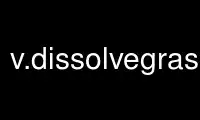
This is the command v.dissolvegrass that can be run in the OnWorks free hosting provider using one of our multiple free online workstations such as Ubuntu Online, Fedora Online, Windows online emulator or MAC OS online emulator
PROGRAM:
NAME
v.dissolve - Dissolves boundaries between adjacent areas sharing a common category number
or attribute.
KEYWORDS
vector, dissolve, area, line
SYNOPSIS
v.dissolve
v.dissolve --help
v.dissolve input=name [layer=string] [column=name] output=name [--overwrite]
[--help] [--verbose] [--quiet] [--ui]
Flags:
--overwrite
Allow output files to overwrite existing files
--help
Print usage summary
--verbose
Verbose module output
--quiet
Quiet module output
--ui
Force launching GUI dialog
Parameters:
input=name [required]
Name of input vector map
Or data source for direct OGR access
layer=string
Layer number or name.
Vector features can have category values in different layers. This number determines
which layer to use. When used with direct OGR access this is the layer name.
Default: 1
column=name
Name of attribute column used to dissolve common boundaries
output=name [required]
Name for output vector map
DESCRIPTION
The v.dissolve module is used to merge adjacent areas in a vector map which share the same
category value. The resulting merged area(s) retains this category value. Alternatively an
integer or string column can be defined which is used to find adjacent polygons with
identical attribute for common boundary dissolving. In this case the categories are not
retained, only the values of the new key column. See the v.reclass help page for details.
NOTES
GRASS defines a vector area as composite entity consisting of a set of closed boundaries
and a centroid. The centroids must contain a category number (see v.centroids), this
number is linked to area attributes and database links.
Multiple attributes may be linked to a single vector entity through numbered fields
referred to as layers. Refer to v.category for more details.
Merging of areas can also be accomplished using v.extract -d which provides some
additional options. In fact, v.dissolve is simply a front-end to that module. The use of
the column parameter adds a call to v.reclass before.
EXAMPLES
Basic use
v.dissolve input=undissolved output=dissolved
Dissolving based on column attributes
North Carolina data set:
g.copy vect=soils_general,mysoils_general
v.dissolve mysoils_general output=mysoils_general_families column=GSL_NAME
Dissolving adjacent SHAPE files to remove tile boundaries
If tile boundaries of adjacent maps (e.g. CORINE Landcover SHAPE files) have to be
removed, an extra step is required to remove duplicated boundaries:
# patch tiles after import:
v.patch -e `g.list type=vector pat="clc2000_*" separator=","` out=clc2000_patched
# remove duplicated tile boundaries:
v.clean clc2000_patched out=clc2000_clean tool=snap,break,rmdupl thresh=.01
# dissolve based on column attributes:
v.dissolve input=clc2000_clean output=clc2000_final col=CODE_00
Use v.dissolvegrass online using onworks.net services
